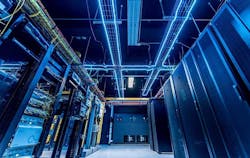H5 Data Centers Continues to Expand, Targeting Regional Growth Markets
The growing adoption of cloud computing and digital content means more data in more places. This trend is creating opportunities for data center providers that extend beyond the traditional business hubs to regional cities, which are in growth mode and a little less crowded.
Among the companies targeting this opportunity is H5 Data Centers, which has built a national network of facilities across 13 markets. The company’s latest expansion is in San Antonio, where H5 has acquired an existing telecom hub at 100 Taylor Street, and will operate the 85,000 square foot building as a carrier-neutral data center.
“Our portfolio of edge data centers continues to grow across the United States,” said Josh Simms, founder and CEO of H5 Data Centers. “H5 Data Centers will continue to build upon the existing interconnection ecosystem at 100 Taylor with a planned build of more than 100 colocation cabinets immediately. We welcome the opportunity to serve a combination of international communications carriers, content distribution networks and cloud services providers.”
Expanding Through Acquisitions
H5 Data Centers is privately held, and in growth mode, managing more than 2 million square feet of data center space. This is the company’s third new market in 2018, having added facilities in Albuquerque, New Mexico and Quincy, Washington. About half of its portfolio is fully leased to single tenants. With its recent acquisitions, H5 is focused on the expanding map of Internet infrastructure.
“It’s been a busy year,” said David Dunn, Chief Operating Office of H5 Data Centers. “We’re growing our business, and trying to be selective in where we invest. We think there’s a lot of opportunity in the Tier 2 and Tier 3 markets. With the right investment and the right strategy, these markets will support additional infrastructure. We think that’s the next evolution for anyone at scale.”
San Antonio fits that model. The region has more than 1 million residents, and a significant data center cluster in its Western suburbs, including a large Microsoft cloud data center, a CyrusOne campus, and several single-tenant enterprise data centers. The city is 120 miles inland, and has a favorable profile for natural disasters, with no history of earthquakes and an average of one tornado a year.
“We think there’s a lot of opportunity in the Tier 2 and Tier 3 markets. With the right investment and the right strategy, these markets will support additional infrastructure. ”
David Dunn, H5 Data Centers
“San Antonio is a very safe place to put a data center,” said Dunn. “It’s a good disaster recovery market compared to Houston with hurricanes and Dallas, which has some tornado risk. We’ve had Microsoft plant its flag here for a major cloud node. We think it’s a great point on the map from a network perspective.”
Despite its growing data center industry, San Antonio does not have a true carrier hotel. The Taylor telecom building has hosted carrier activity since the early days of the Internet, but could support a more robust interconnection business.
“We thought it was a good opportunity to come in and make some investments in the building infrastructure,” said Dunn. “That really wasn’t part of the previous owner’s business model. It’s a very carrier-based ecosystem. We’re going to come in and build out the electrical and mechanical capacity and target some of the content and cloud providers.”
Looking Beyond Tier 1 Markets
H5 now operates data centers in regional hubs like Albuquerque, Charlotte, Cincinnati, Cleveland, Denver, and San Luis Obispo, Calif. It also has facilities in large markets, including Phoenix, Silicon Valley (San Jose) and Seattle. For now, it’s focusing on regional markets.
“We feel the Tier 1 markets are pretty solid in terms of development and competition,” said Dunn. “There’s not a really a good opportunity to enter these markets, in our opinion.”
H5 has a property in a prime location in the industry’s hottest market in Ashburn, Virginia. H5 bought the site as an investment, positioning it as a powered shell opportunity for a larger service provider. Dunn noted that the market in Ashburn is now focused on turn-key data center space.
But he believes the company’s building at 21800 Beaumeade Circle, near the heart of Ashburn’s Data Center Alley, will offer an opportunity for someone. “It’s a great location in the world’s busiest market,” said Dunn.
In the meantime, H5 will continue to scan the horizon for opportunities.
“I think we’re going to continue to grow steadily,” said Dunn. “We have been spreading a wide net. We’ll look at several new markets in 2019, and also go deeper into some of our existing markets with additional capacity. There’s definitely some markets we like and want to get into.”
About the Author


